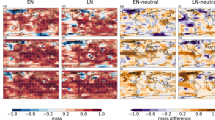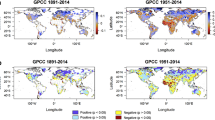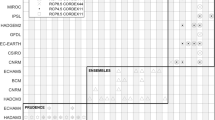Abstract
The assessment of predictability for decadal predictions of quantities like temperature and precipitation typically focuses on regional and temporal mean values. However, changes in extremes can be different to changes in mean climate, and accordingly their predictability may be different. We use simulations from CSIRO-Mk3-6-0 (CMIP5 archive) to set up a ‘perfect model’ experiment to compare the predictability for mean and extreme temperature and precipitation on interannual to decadal time-scales. The results show that both the mean and likelihood of near-surface temperature extremes is potentially predictable in many regions in the first lead year, while the areas with precipitation predictability tend to be mostly in low-latitude regions during this period. On decadal time scales, significant potential skill for mean and extreme temperatures is found over the North Atlantic and Southern Ocean but also over some land areas including North Africa, Europe and North America. The general spatial patterns of predictability are very similar between the mean and extremes. However, indices of moderate temperature extremes in particular show a tendency towards higher predictability than the mean. The approach to studying predictability presented here uses international coordinated model intercomparison project simulations. However a larger number of different initializations would be required from more models to allow improved robustness of the results.










Similar content being viewed by others
References
Alexander LV, Uotila P, Nicholls N (2009) Influence of sea surface temperature variability on global temperature and precipitation extremes. J Geophys Res 114:D18116. https://doi.org/10.1029/2009JD012301
Boer GJ (2000) A study of atmosphere-ocean predictability on long time scales. Clim Dyn 16(6):469–477
Boer GJ (2004) Long time-scale potential predictability in an ensemble of coupled climate models. Clim Dyn 23(1):29–44
Boer GJ, Lambert SJ (2008) Multi-model decadal potential predictability of precipitation and temperature. Geophys Res Lett 35(5):L05706. https://doi.org/10.1029/2008GL033234
Boer GJ, Kharin VV, Merryfield WJ (2013) Decadal predictability and forecast skill. Clim Dyn 41(7–8):1817–1833
Branstator G, Teng H (2010) Two limits of initial-value decadal predictability in a CGCM. J Clim 23(23):6292–6311
Collins M (2002) Climate predictability on interannual to decadal time scales: the initial value problem. Clim Dyn 19(8):671–692
Collins M, Botzet M, Carril AF, Drange H (2006) Interannual to decadal climate predictability in the North Atlantic: a multimodel-ensemble study. J Clim 19:1195–1203
Doblas-Reyes FJ, Balmaseda MA, Weisheimer A, Palmer TN (2011) Decadal climate prediction with the European Centre for Medium-Range Weather Forecasts coupled forecast system: impact of ocean observations. J Geophys Res 116:D19
Doblas-Reyes FJ et al (2013) Initialized near-term regional climate change prediction. Nat Commun 4:1715. https://doi.org/10.1038/ncomms2704
Donat MG et al (2013) Updated analyses of temperature and precipitation extreme indices since the beginning of the twentieth century: the HadEX2 dataset. J Geophys Res Atmos 118:2098–2118. https://doi.org/10.1002/jgrd.50150
Donat MG, Pitman AJ, Seneviratne SI (2017) Regional warming of hot extremes accelerated by surface energy fluxes. Geophys Res Lett 44(13):7011–7019
Eade R, Hamilton E, Smith DM, Graham RJ, Scaife AA (2012) Forecasting the number of extreme daily events out to a decade ahead. J Geophys Res Atmos 117(D21):D03114. https://doi.org/10.1029/2011JD016541
Eade R et al (2014) Do seasonal-to-decadal climate predictions underestimate the predictability of the real world? Geophys Res Lett 41(15):5620–5628
Gent PR et al (2011) The community climate system model version 4. J Clim 24(19):4973–4991
Goddard L et al (2013) A verification framework for interannual-to-decadal predictions experiments. Clim Dyn 40(1–2): 245–272
Gonzalez PLM, Goddard L (2015) Long-lead ENSO predictability from CMIP5 decadal hindcasts. Clim Dyn 46(9–10):3127–3147
Griffies SM, Bryan K (1997) A predictability study of simulated North Atlantic multidecadal variability. Clim Dyn 13(7–8):459–487
Grötzner A, Latif M, Timmermann A, Voss R (1999) Interannual to decadal predictability in a coupled ocean-atmosphere general circulation model. J Clim 12(8):2607–2624
Guemas V et al (2013) The Indian Ocean: the region of highest skill worldwide in decadal climate prediction. J Clim 26(3):726–739
Hanlon HM, Hegerl GC, Tett SFB, Smith DM (2013) Can a decadal forecasting system predict temperature extreme indices?. J Clim 26(11):3728–3744
Hansen J, Ruedy R, Sato M, Lo K (2010) Global surface temperature change. Rev Geophy 48:RG4004. https://doi.org/10.1029/2010RG000345
Hawkins E, Sutton R (2009) The potential to narrow uncertainty in regional climate predictions. Bull Am Meteor Soc 90(8):1095–1107
Hawkins E, Smith RS, Gregory JM, Stainforth DA (2015) Irreducible uncertainty in near-term climate projections. Clim Dyn 46(11–12):3807–3819
Hobday AJ et al (2016) A hierarchical approach to defining marine heatwaves. Prog Oceanogr 141:227–238
Illing S, Kadow C, Oliver K, Cubasch U (2014) MurCSS: a tool for standardized evaluation of decadal hindcast systems. J Open Res Softw 2(1):p.e24. https://doi.org/10.5334/jors.bf
Kadow C et al (2016) Evaluation of forecasts by accuracy and spread in the MiKlip decadal climate prediction system. Meteorol Z 25(6):631–643
Kirtman B, Power SB, Adedoyin JA, Boer GJ, Bojariu R, Camilloni I, Doblas-Reyes FJ, Fiore AM, Kimoto M, Meehl GA, Prather M, Sarr A, Schär C, Sutton R, van Oldenborgh GJ, Vecchi G, Wang HJ (2013) Near-term climate change: projections and predictability. In: Stocker TF, Qin D, Plattner G-K, Tignor M, Allen SK, Boschung J, Nauels A, Xia Y, Bex V, Midgley PM (eds) Climate change 2013: the physical science basis. Contribution of Working Group I to the fifth assessment report of the intergovernmental panel on climate change. Cambridge University Press, Cambridge
Kruschke T, Rust HW, Kadow C, Leckebusch GC, Ulbrich U (2014) Evaluating decadal predictions of northern hemispheric cyclone frequencies. Tellus A Dyn Meteorol Oceanogr 66(1):22830
Kruschke T et al (2016) Probabilistic evaluation of decadal prediction skill regarding Northern Hemisphere winter storms. Meteorol Z 25(6):721–738
Kumar A, Peng PT, Chen MY (2014) Is there a relationship between potential and actual skill? Mon Weather Rev 142(6):2220–2227
Lorenz EN (1969) Atmospheric predictability as revealed by naturally occurring analogues. J Atmos Sci 26:236–246
McPhaden MJ, Zebiak SE, Glantz MH (2006) ENSO as an integrating concept in earth science. Science 314(5806):1740–1745
Mulholland DP, Laloyaux P, Haines K, Balmaseda MA (2015) Origin and impact of initialization shocks in coupled atmosphere-ocean forecasts. Mon Weather Rev 143(11):4631–4644
Murphy AH (1988) Skill scores based on the mean-square error and their relationships to the correlation-coefficient. Mon Weather Rev 116(12):2417–2425
Murphy AH, Epstein ES (1989) Skill scores and correlation-coefficients in model verification. Mon Weather Rev 117(3):572–581
Pegion K, DelSole T, Becker E, Cicerone T (2017) Assessing the fidelity of predictability estimates. Clim Dyn. https://doi.org/10.1007/s00382-017-3903-7
Pohlmann H, Botzet M, Latif M, Roesch A, Wild M, Tschuck P (2004) Estimating the decadal predictability of a coupled AOGCM. J Clim 17:4463–4472
Rotstayn LD et al (2012) Aerosol- and greenhouse gas-induced changes in summer rainfall and circulation in the Australasian region: a study using single-forcing climate simulations. Atmos Chem Phys 12(14):6377–6404
Schneider U, Becker A, Finger P, Meyer-Christoffer A, Rudolf B, Ziese M (2015) GPCC full data monthly product version 7.0 at 1.0°: monthly land-surface precipitation from rain-gauges built on GTS-based and historic data. https://doi.org/10.5676/DWD_GPCC/FD_M_V7_100. Accessed 05 Dec 2018
Sillmann J, Kharin VV, Zwiers FW, Zhang X, Bronaugh D (2013) Climate extremes indices in the CMIP5 multimodel ensemble: part 2. Future climate projections. J Geophys Res Atmos 118(6):2473–2493
Smith DM et al (2007) Improved surface temperature prediction for the coming decade from a global climate model. Science 317(5839):796–799
Smith DM et al (2010) Skilful multi-year predictions of Atlantic hurricane frequency. Nat Geosci 3(12):846–849
Taylor KE, Stouffer RJ, Meehl GA (2012) An overview of CMIP5 and the experiment design. Bull Am Meteorol Soc 93(4):485–498
van Oldenborgh GJ, Doblas-Reyes FJ, Wouters B, Hazeleger W (2012) Decadal prediction skill in a multi-model ensemble. Clim Dyn 38(7–8):1263–1280
Watanabe M et al (2010) Improved climate simulation by MIROC5. Mean states, variability, and climate sensitivity. J Clim 23(23):6312–6335
Zhang X et al (2011) Indices for monitoring changes in extremes based on daily temperature and precipitation data. Wiley Interdiscip Rev Clim Change 2(6):851–870
Acknowledgements
This study was supported by the Australian Research Council Grants CE110001028, CE170100023, DE150100456 and DP150101331, the Spanish Ministry for the Economy, Industry and Competitiveness Ramón y Cajal 2017 Grant reference RYC-2017-22964, and the Australia-Germany Joint Research Co-operation (German Academic Exchange Service, DAAD) Grand ID 57219579. We thank the climate modeling groups contributing to CMIP5 for producing and making available their model output. We also acknowledge the Miklip (Mittelfristige Klimaprognose, http://www.fona-miklip.de/) Evaluation System hosted by the German Climate Computing Center (Deutsches Klimarechenzentrum, DKRZ), which was used to perform part of the analyses.
Author information
Authors and Affiliations
Corresponding author
Additional information
Publisher’s Note
Springer Nature remains neutral with regard to jurisdictional claims in published maps and institutional affiliations.
Electronic supplementary material
Below is the link to the electronic supplementary material.
Rights and permissions
About this article
Cite this article
Liu, Y., Donat, M.G., Rust, H.W. et al. Decadal predictability of temperature and precipitation means and extremes in a perfect-model experiment. Clim Dyn 53, 3711–3729 (2019). https://doi.org/10.1007/s00382-019-04734-z
Received:
Accepted:
Published:
Issue Date:
DOI: https://doi.org/10.1007/s00382-019-04734-z




